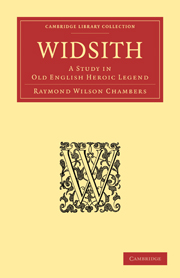Book contents
- Frontmatter
- PREFACE
- Contents
- CORRECTIONS AND ADDITIONAL NOTES
- CHAP. I WIDSITH AND THE GERMAN HEROIC AGE
- CHAP. II THE STORIES KNOWN TO WIDSITH: GOTHIC AND BURGUNDIAN HEROES
- CHAP. III THE STORIES KNOWN TO WIDSITH: TALES OF THE SEA-FOLK, OF THE FRANKS AND OF THE LOMBARDS
- CHAP. IV WIDSITH AND THE CRITICS
- CHAP. V THE GEOGRAPHY OF WIDSITH
- CHAP. VI THE LANGUAGE AND METRE OF WIDSITH
- CHAP. VII SUMMARY AND CONCLUSION
- TEXT OF WIDSITH, WITH NOTES
- APPENDIX
- MAPS AND INDEX
CHAP. V - THE GEOGRAPHY OF WIDSITH
Published online by Cambridge University Press: 16 May 2011
- Frontmatter
- PREFACE
- Contents
- CORRECTIONS AND ADDITIONAL NOTES
- CHAP. I WIDSITH AND THE GERMAN HEROIC AGE
- CHAP. II THE STORIES KNOWN TO WIDSITH: GOTHIC AND BURGUNDIAN HEROES
- CHAP. III THE STORIES KNOWN TO WIDSITH: TALES OF THE SEA-FOLK, OF THE FRANKS AND OF THE LOMBARDS
- CHAP. IV WIDSITH AND THE CRITICS
- CHAP. V THE GEOGRAPHY OF WIDSITH
- CHAP. VI THE LANGUAGE AND METRE OF WIDSITH
- CHAP. VII SUMMARY AND CONCLUSION
- TEXT OF WIDSITH, WITH NOTES
- APPENDIX
- MAPS AND INDEX
Summary
However wide his wanderings, no poet could know equally well the national sagas of all the Germanic tribes, and we shall find that the stories known to Widsith are those belonging particularly to two of the five great divisions of the Germanic race, as it existed in the early centuries of our era.
But in any attempt to classify, into their groups and subgroups, the tribes and heroes of Widsith, we are met at the outset by the difficulty of an unsettled terminology. The result is that this chapter cannot be written as simply as might have been wished.
Linguistic Classifications
In trying to realize these ethnographical divisions of ancient Germany, scholars have had to rely chiefly upon linguistic evidence, and this evidence only gives up its secrets very gradually. More and more accurate results are obtained, but even the final result is only an approximation to the truth.
Hence the old classification—Scandinavian, Low German, High German—has been superseded by that of Scandinavian or North Germanic, West Germanic (embracing both Low and High German) and East Germanic (embracing Gothic and the other kindred tongues).
Yet even this perhaps does not represent ultimate truth. The so-called “Northern” and “Eastern” families are possibly more intimately interrelated. Even if the purely linguistic evidence is not strong enough to establish this connection—and many scholars have held that it is—there remains the significant fact that the same tribal names, Rugian and Vandal, East Goth and West Goth, occur in both the Northern and the Eastern family, but not in the West.
- Type
- Chapter
- Information
- WidsithA Study in Old English Heroic Legend, pp. 153 - 165Publisher: Cambridge University PressPrint publication year: 2010First published in: 1912

